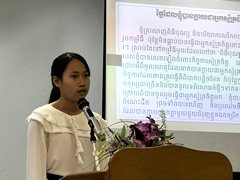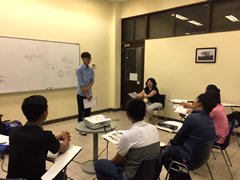Initiatives of the CJCC Japanese-Language Course
Cambodia-Japan Cooperation Center (CJCC)
KOJIMA Kaori
Cambodia is a country with a population of around 15 million people that is located on the Indochinese Peninsula. It shares borders with Vietnam, Laos and Thailand. In the capital of Phnom Penh, buildings are going up and the city is a constant hive of activity. Accompanying the country’s development, even when it comes to Japanese-language education in Cambodia efforts are moving rapidly ahead to train the human resources who will oversee the future, such as personnel with the Japanese-language skills needed for working or studying abroad. The activities of the Cambodia-Japan Cooperation Center (hereinafter “CJCC”), where I am based, comprise three pillars – Business Training, Japanese Language for Career Development, and a Culture and Education Exchange Program – and it is operated through the support of Japan and Cambodia. Here, I will introduce some of the Japanese-language education initiatives at the CJCC.
1. CJCC Student Speech Contest

CJCCThe CJCC Student Speech Contest
Once a year, the CJCC holds a speech contest for students taking its Japanese-language course. Contestants are divided into seniors and juniors, and all learners, from beginner level through to intermediate level, have a chance to participate, so it is also a venue for demonstrating the results of their daily Japanese-language learning. This year the contest was held on March 18. The title of the speeches that claimed magnificent victories were “Work” (senior division) and “Cooked rice” (junior division). Both speeches focused on one aspect of everyday life, and the thoughts that the speakers wanted to convey were skillfully collated and presented. In the future also, I hope to incorporate many initiatives such as this speech contest at CJCC in the future, in the hope that learners look back positively at having studied Japanese at CJCC.
2. Opening Ceremony
The CJCC has a two-semester system, with new semesters starting every year in April and September. On the first day of the semester, an opening ceremony is held at the Angkor-Kizuna Hall, a large venue within the CJCC. As someone dispatched to the CJCC as a Japanese-Language Specialist, from this year I have been utilizing the opportunity provided by this opening ceremony to showcase The Japan Foundation (hereinafter the “JF”)’s initiatives, The JF Japanese-language course, and the course book “Marugoto: Japanese Language and Culture” (hereinafter the “Marugoto”). One key aim is to ensure that all the students taking the course are aware that they have “companions” who are using “Marugoto” to study in various countries worldwide, not just in Cambodia.
3. Introducing the “Marugoto: Japanese Language and Culture” Intermediate Class

“Marugoto Class 6”
The regular course for the semester commencing in April 2017 is offering classes at seven levels, from “Marugoto Starter” to “Marugoto Intermediate 2.” In total there are 436 learners studying Japanese at CJCC. Here, I would like to introduce one of those classes, “Marugoto Class 6.” This class is held in the evenings (6:00 p.m.–7:30 p.m.) twice a week (Tuesdays and Thursdays), with each lesson lasting 90 minutes. Over a total of 43 sessions from April to September students study the second half of “Marugoto Intermediate 1.”
The Japanese classes in “Marugoto Intermediate 1” include “Using notes to sum up and talk at length about the plot of a manga, folk tale or novel that you like.” All the class members engaged in the task enthusiastically, and even held a mini-presentation that they organized themselves. There were some interesting discoveries, including that rabbits make frequent appearances in Cambodian folk tales, and that the plots resemble those in Japanese folk tales. I hope to employ more and more lesson devices that make it possible to uncover interesting things not only from exchanges between Japanese and Cambodian people, but also from exchanges between the classmates themselves.
- What We Do Top
- Arts and Cultural Exchange [Culture]
- Japanese-Language Education Overseas [Language]
- Japanese-Language Education Overseas [Language] Top
- Learn Japanese-language
- Teach Japanese-language
- Take Japanese-Language Test
- Know about Japanese-language education abroad
- The Japanese-Language Institute, Urawa
- The Japanese-Language Institute, Kansai
- Japanese-Language Programs for Foreign Specified Skilled Worker Candidates
- Japanese Language Education for Japanese Children Resident Overseas and for the Descendants of Migrants
- Archives
- Japanese Studies and Global Partnerships [Dialogue]
- JF digital collection
- Other Programs / Programs to Commemorate Exchange Year
- Awards and Prizes
- Publications
